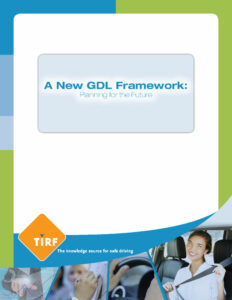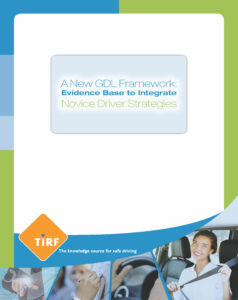Welcome to the GDL Framework Safety Center
 The Graduated Driver Licensing (GDL) Framework Safety Center offers a comprehensive approach to young driver safety. Using the GDL Framework previously developed by the Traffic Injury Research Foundation (TIRF), in partnership with the National Safety Council (NSC) and the National Highway Traffic Safety Administration (NHTSA), the GDL Framework Safety Center was created by TIRF with input from experienced young driver stakeholders in three jurisdictions and consultation with Allan Williams. It contains relevant research, tacit knowledge, and a suite of practical tools and resources to support efforts by jurisdictions to implement one or more components of the Framework to enhance their existing young driver strategy. This work was made possible with support from the NSC and funding provided by NHTSA.
The Graduated Driver Licensing (GDL) Framework Safety Center offers a comprehensive approach to young driver safety. Using the GDL Framework previously developed by the Traffic Injury Research Foundation (TIRF), in partnership with the National Safety Council (NSC) and the National Highway Traffic Safety Administration (NHTSA), the GDL Framework Safety Center was created by TIRF with input from experienced young driver stakeholders in three jurisdictions and consultation with Allan Williams. It contains relevant research, tacit knowledge, and a suite of practical tools and resources to support efforts by jurisdictions to implement one or more components of the Framework to enhance their existing young driver strategy. This work was made possible with support from the NSC and funding provided by NHTSA.
 The GDL Framework was first developed through several phases of scientific review, an environmental scan of current and best practices, and an international expert panel discussion to better protect young drivers and reduce their elevated crash risk. It integrates an evidence-based GDL program with other best practice strategies for teens including driver education, license testing and in-vehicle monitoring technologies. The GDL Framework Safety Center presents and expands upon this comprehensive Framework, providing a series of practical resources and tools made freely available to states, allowing for the better integration of young driver safety initiatives within an optimal GDL program.
The GDL Framework was first developed through several phases of scientific review, an environmental scan of current and best practices, and an international expert panel discussion to better protect young drivers and reduce their elevated crash risk. It integrates an evidence-based GDL program with other best practice strategies for teens including driver education, license testing and in-vehicle monitoring technologies. The GDL Framework Safety Center presents and expands upon this comprehensive Framework, providing a series of practical resources and tools made freely available to states, allowing for the better integration of young driver safety initiatives within an optimal GDL program.
The GDL Framework Safety Center is organized in several modules:
- The Issue: This module contains a high level overview of research evidence regarding the magnitude and characteristics of the young driver crash problem. The research in this module provides a clear rationale and demonstrates the importance of improvements to young driver safety programs.
- GDL Framework: This module provides more detailed background and context for the GDL Framework. The components of the Framework are described along with the expected benefits associated with implementation of the Framework.
- Components: This module contains detailed information about each of the framework components according to their ease of implementation. Each component is explored in terms of description and rationale; key research findings; implementation status; implementation activities; and external resources. Components with greater feasibility also have associated tools to guide effective
implementation. - Implementation: This module contains important contextual information that states can use to develop a realistic implementation strategy, as well as a checklist to support the strategy. The content in this section helps jurisdictions determine what components of the Framework are most relevant to their jurisdiction, and whether components should be pursued individually or the packaging of two or more components is appropriate. It includes materials to help states identify current practices that would have to be modified as part of implementation, training needs, and costs of implementation.
- Resources: This module contains a variety of external resources, such as links to publications and research studies providing more detailed information on a variety of young driver topics.
